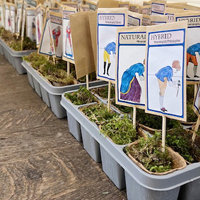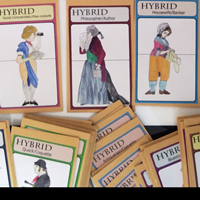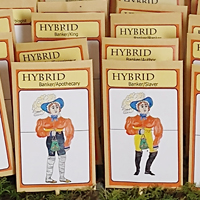Propagation
Propagation operates as a playful but critical commentary on eighteenth-century discourses of reproduction, classification, and social order. Comprising 1,152 individual "seed packets" placed in modular seed trays, the work draws a formal parallel between botanical propagation and human reproduction. Using the same forty-eight people of interest, documented in the artwork GAME, each packet features a caricature: the head and torso of a male or female figure conjoined with the lower half of a body of the opposite sex. These composite figures are categorised as 'Natural' or 'Hybrid' designed to mimic both horticultural classification systems and the hierarchical language of eighteenth-century social taxonomy. Through this visual language, Propagation interrogates the boundaries of gender, class, and legitimacy in elite society, positing sexual reproduction and taxonomic control as closely entwined cultural mechanisms for maintaining power.
The central concept of Propagation is hybridisation, biological, intellectual, and social. The Linnaean system of plant taxonomy, which was explicitly rooted in a sexualised reading of plant reproduction, in which the marriage of stamens and pistils was metaphorically mapped onto human relations. The artwork uses this historical linkage as a basis for satirical critique. By literally hybridising its human subjects, the piece both mirrors and exaggerates the Linnaean logic. These figures, like the plants they stand for, are subjected to a classificatory impulse that seeks to define, name, and delimit identity through pairings and reproductive metaphors. But in doing so, Propagation undermines the very authority of that system, revealing it to be contingent, ideological, and laced with patriarchal assumptions.
The structure and presentation of Propagation consciously mimics the ordered aesthetics of scientific cultivation. The trays, reminiscent of a nursery or greenhouse, evoke Enlightenment ambitions to control and catalogue the natural world. But here, instead of varieties of plants, the viewer encounters bizarre cross-bred identities of Class, such as Missionary/Actress, Apothecary/Coquette, or Cuckold/Queen. The combination of professions and social types destabilise both class and gender categories. Some labels invoke respectable Enlightenment vocations, others scandalous or eroticised stereotypes; all are drawn from a lexicon of eighteenth-century roles. By assembling these parts into uncanny hybrids, Propagation stages a form of social cross-breeding, calling attention to the artificiality and cultural construction of both scientific and social classification systems.



